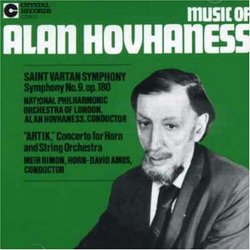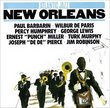| All Artists: Alan Hovhaness, David Amos, Israel Philharmonic Orchestra, National Philharmonic Orchestra of London Title: Music of Alan Hovhaness: Saint Vartan Symphony; Artik Members Wishing: 1 Total Copies: 0 Label: Crystal Records Release Date: 8/19/1993 Genre: Classical Styles: Forms & Genres, Concertos, Historical Periods, Modern, 20th, & 21st Century, Instruments, Brass, Symphonies Number of Discs: 1 SwapaCD Credits: 1 UPC: 009414780225 |
Search - Alan Hovhaness, David Amos, Israel Philharmonic Orchestra :: Music of Alan Hovhaness: Saint Vartan Symphony; Artik
 | Alan Hovhaness, David Amos, Israel Philharmonic Orchestra Music of Alan Hovhaness: Saint Vartan Symphony; Artik Genre: Classical
|
Larger Image |
CD DetailsSimilarly Requested CDs
|
CD ReviewsDon't judge a cd by its cover Thaddeus Wert | Nashville, TN USA | 05/18/2003 (5 out of 5 stars) "This disc sports what has to be some of the ugliest cover art ever allowed out in public: a distinctly unflattering black and white photo of Hovhaness cut-and-pasted onto a sickly, solid green background. While this does not bode well for the contents within, the brave consumer will be rewarded, for Saint Vartan's Symphony is one of the most beautiful pieces of classical music ever recorded. While not a symphony in the "classic" sonata form, it is still a complex and massive work. There are twenty-four (!) short movements that vary from dance-like pieces to solemn ceremonial ones. Overall, it is an organic work that builds in intensity to an emotional climax. What is Hovhaness' genius is his ability to meld Eastern modes of music with Western canons into a seamless and unique work whose sum is far greater than its parts. Nowadays, with the well-deserved popularity of Part, Gorecki, Taverner, Rautavaara, Glass, and Reich, this does not seem like such a big deal. What is incredible is that Hovhaness composed this symphony in 1949-50! Almost all of the aforementioned contemporary composers owe Alan Hovhaness a huge stylistic debt. If you are attracted to any of their works, do yourself a favor and check out Hovhaness' music. This disc is an excellent place to start." Superb Classical Music! But the cover is a real howler!!! Patrick W. Crabtree | Lucasville, OH USA | 01/04/2008 (5 out of 5 stars) "I listen to this spectacular symphony EVERY night... I mean EVERY night, mostly as I read. Right behind this CD, I also listen to another set of Hovhaness's works which offer a similarly wonderful ambiance: Hovhaness: Symphonies Nos. 4, 20 & 53; The Prayer of St. Gregory Alan Hovhaness, (1911-2000), an American composer of Armenian heritage, spent a lot of time in the Middle East and in the Orient; a bit of that flavour comes through on this fine recording, mostly in regard to the subtle bells which are manifest in the work. No, this isn't 'Asian Music' by any means -- in fact, if you were unaware of Hovhaness's Eastern studies then you would probably have difficulty in putting your finger on exactly what makes his work so beautifully unique to all other Classical Music. The Saint Vartan Symphony No. 9 runs a total of 43:51 and is in two parts, conveying a total of 24 short "movements"; however, you won't find it piecemeal -- it's all fluid and flowing. The second composition is "Artik," (Concerto for horn and string orchestra). This music is very similar in atmosphere to Saint Vartan. It's ludicrous to attempt to verbally define the music found herein so I'll just say this: This music would have made a fine soundtrack (in part) for "The Lord of Rings" or even for the "Cadfael" series, albeit, it has little to do with either of those locations or periods. That having been said, I'll just summarize by noting that the COVER of this album/CD makes the great Alan Hovhaness look like some fashion of circus freak. The folks at Crystal Records should have been horse-whipped for releasing this ridiculous artwork and dubious cover photo. So I want to make sure that you all know WHODUNNIT: "Folder design, Ed Mitchell," whomever HE is. Get this CD and treat yourself to a superb Classical Music experience." Ugly disc, fantastic symphony Russ | Richmond, VA | 05/12/2007 (5 out of 5 stars) "The majority of the 67 numbered symphonies of American composer Alan Hovhaness (1911-2000) remain uncharted territory. And this is territory which should certainly be fully explored. But several of Hovhaness' symphonies have been recorded - and are available. If you are new to Hovhaness, I recommend acquiring a copy of his "Mysterious Mountain" symphony - a fine recording is available on the Telarc label. However, if you know that work and want more, this release can be fully recommended.
The Saint Vartan symphony, completed in 1950, takes its name from a great 5th century Armenian leader (I presume - the program notes are not detailed). This 44-minute work is divided into two parts, with each part consisting of several brief movements. Some of these movements are noble and serene, as one who is somewhat familiar with Hovhaness may expect. But such movements are separated by highly energetic, and exciting, dances. If you only have had a passing acquaintance with Hovhaness' music, this may come as a surprise. The symphony is primarily scored for string orchestra, brass, timpani, and vibraphone. Woodwind involvement is limited to a brief alto saxophone melody heard at the opening of Part Two. Hovhaness employs several techniques which make his music readily identifiable. One such technique is his heavy use of pizzicato, which sometimes is used to provide harmonic support, while in other circumstances a pizzicato "murmuring" underpins the melody giving the music an interesting texture. Another Hovhaness calling card is his distinctive use pitched percussion, often giving his music an ethereal feel. In the Saint Vartan symphony, it is the tremolo of vibraphone that serves this purpose (used similarly in the excellent "City of Light" symphony). Hovhaness' use of polyphony brings to mind the baroque period (several canons are incorporated into the symphony) but the simplicity of several of the themes seems to look ahead to the minimalist school. In short, I like Hovhaness, and I really like this symphony. The melodic ideas in this symphony are not as extended in comparison to some of Hovhaness' other works, yet this work is filled with all of the majesty that is present in Hovhaness better known compositions. And the startling and dramatic conclusions to each of the two sections, featuring a martial, galloping trumpet melody are definitely exciting. It should also be mentioned that the concerto for horn and string orchestra, while not varied, does contain some beautiful moments as well, especially the haunting processional. The symphony was recorded in 1974, but it is difficult to tell the recording is that old, as the audio quality is quite good. My only reservation, other than the green disc cover, is that the orchestra does not end together in the complicated conclusion to the symphony (I think one violin player may have gotten lost in the fray). But this seems to be an isolated issue, and is not enough from preventing me giving this release my full recommendation to Hovhaness devotees and newcomers alike. TT: 61:54" |

 Track Listings (3) - Disc #1
Track Listings (3) - Disc #1



